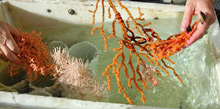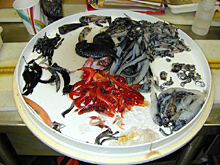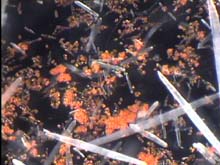
A microscope photograph shows the difference between sclerites of two different coral species. The ‘warty’ orange sclerites are from Paragorgia sp. and the pin-shaped clear sclerites are from Lepidisis sp. Photo by S. France. Click image for larger view.
A Day of Firsts
July 15, 2003
Maya Crosby
Lincoln Academy, Newcastle, ME
Pat Frisketti
Hamden High School, Hamden, CT
Diana Payne
Connecticut Sea Grant
When I was a child, I thought that all the world was known. It was taught to me so. I thought the list of explorers complete, the species and their habitats all cataloged.
-Cindy Lee Van Dover, The Octopus’s Garden
A sea bed seems beautiful the first time, when you discover it; but, as with all things, the really beautiful part comes later, when you learn everything….
-Italo Calvino, Difficult Loves
Today was the first Alvin diveon the Kelvin seamount! Because multibeam bathymetry ofKelvin was completed earlier in the cruise, the scienceteam was able to strategically plan the dive on this seamount.
Kelvin seamount has two peaks. The tallest peak rises approximately 3425m above the abyssal plain, while the smaller peak rises to approximately 3208m. According to nautical charts, Kelvin is right in the path of the Gulf Stream. This was confirmed by R/V Atlantis Chief Mate Mitzi Crane.
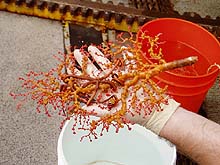
A Paragorgia sp. coral overgrown with an unknown zoanthid colony. A large ophiuroid (brittle star) is also seen wrapped around the Paragorgia. Photo by M. Crosby. Click image for larger view.
While Dr.Les Watling, Anne Simpson and Alvin pilot Bruce Strickrott began the descent to Kelvin, the science team on board Atlantis completed the preservation of specimens from yesterday’s dive to Manning seamount. An additional task was to finalize the duplication of videotapes from the dive. During this process, the scientists can review the tape to isolate specimens of interest. Dr. Peter Auster and Dr. Jon Moore have been helping the Ocean Explorer Team locate the footage showing the best images of the organisms – particularly the fish. The tapes will later be used to specifically identify these organisms. While in Alvin, the scientists gather density (number of organisms) and behavioral data, which will be used to understand more about the nature of the seamount ecosystem as a habitat.
Meanwhile, Dr. Scott France works through samples of deep sea coral polyps. He is particularly interested in sclerites – small pieces of calcified material found inside polyps or as a skeletal material around them. Sclerites are used for support or for defense, and some polyps even have large medieval-looking sclerites that encase the polyp and act as a “lid.” Dr. France is comparing the differences between the sclerites of the Lepidisis sp.(bamboo coral) and Paragorgia sp. The sclerites of the Lepidisis sp. are clear and look like small pins with rounded ends, and are aligned lengthwise around each other to provide structure to the polyp. The Paragorgia sp. has “bumpy” orange-pigmented sclerites, which coral biologists call “warty,” and have tubercles.
Scientists are interested in coral taxonomy and how to identify corals based on the shape and size of their sclerites. In the past, coral taxonomy was routinely done this way, using a 1936 classic volume from the Harvard Museum of Comparative Zoology. Dr. France is now using mitochondrial DNA to explore the evolutionary relationships between deep sea corals. However, the DNA information does not agree with the classical taxonomy completed using sclerites. Scientists, including Dr. France and Dr. Les Watling, are exploring a new taxonomy that could combine mitochondrial DNA and sclerite information.
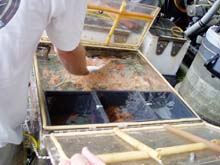
The biobox, or collecting box on the front of Alvin filled with gorgonian specimens. Photo by M. Crosby. Click image for larger view.
As Alvin returned to the surface this afternoon, the biobox was once again overflowing with deep sea coral samples! But another first for DSV Alvin dive 3903 was University of Maine graduate student Anne Simpson’s inaugural dive!
In the laboratory, Anne’s project is to research reproductive morphology in several families of gorgonians. She examines the structure of reproductive cells using transmission electron microscopy (TEM), which will show the details of the cells. To obtain samples for TEM, each polyp must be carefully snipped from the octocoral and preserved in fixative. The coral pieces must be smaller than 1mm so the fixative can infuse all of the tissues.
The morphology of the reproductive tissues can tell scientists about the ecology of the animal, and perhaps its reproductive strategy. Coral eggs were obtained from the first Mountains in the Sea dive. Studies of eggs and sperm from different species of octocoral may also show that species reproduce in different ways. It is also hoped that this information can be used to decipher taxonomic relationships between octocorals. Tonight, it will take 5-6 hours to complete the first process of fixation, with the assistance of University of Maine graduate students Betsy Grannis and Skip Forest. Upon returning to the lab, specimens will be observed using an electron microscope. It will take at least one year to fully examine all the specimens collected on this cruise!
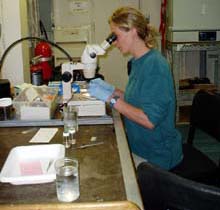
Anne Simpson, a University of Maine graduate student who dove in Alvin for the first time today, works with the coral polyp samples she collected. Photo by M. Crosby. Click image for larger view.
Anne’s goal is to collect as many different types of gorgonians as possible. She had an opportunity to experience collection firsthand as she climbed into Alvin for the first time! “I wasn’t too nervous,” she said. “I didn’t let myself get too excited, because I was afraid something would happen and I wouldn’t be able to go after all. When we got into the sub and started diving - then I was excited!”
When asked about her first Alvin dive, Anne noted ‘There are really just no words to describe it. I would do it again in a second. If I had any engineering or navigation skills, I would love to be a pilot – and see things never before seen. The landscape is spectacular enough, but then it is spiked with crazy animals everywhere!”
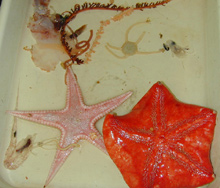
Miscellaneous invertebrates collected during the 2000 cruise to Bear seamount. Photo by Michael Vecchione.Click image for larger view.
Working Together to Achieve a Common Goal: Exploring the New England Seamounts
July 15, 2003
Mercer R. Brugler
Grice Marine Laboratory
College of Charleston, Charleston, SC
Dr. Jon Moore
Florida Atlantic University
Wilkes Honors College, Jupiter, FL
Even before this cruise, the many scientists looking to study the New England (NE) seamounts knew it would take more than a single effort to accurately characterize even a small piece of this seamount chain. The first investigation of the organisms on these seamounts was a series of trawls conducted by the National Marine Fisheries Service (NMFS) in December 2000 at the closest seamount to the United States, Bear Seamount. That cruise provided the first glimpse of the animals on only one of the more than 30 seamounts in this chain. The faunal list was compiled from identifications made by several scientific experts after the cruise and is currently in press.
In September of 2001, a team of deep-sea scientists set out on the Deep East expedition to study two of the NE seamounts (Bear and Physalia), but due to bad weather (Hurricane Erin), they were confined to working in two areas on the continental slope of George’s Bank, Oceanographer and Hydrographer canyons. Close in proximity to the northernmost seamount in the NE seamount chain (Bear Seamount), the canyons, which are often characterized by swift currents and similar fauna, afforded the scientific crew an opportunity to achieve several of their goals.
The Deep East expedition had several objectives. The primary objective was to characterize the various types of coral and fishes associated with the NE seamounts using the occupied submersible Alvin. Other goals included describing coral distribution, invertebrates associated with the corals, fish diversity, and the reproductive biology of corals.
Unfortunately, only one task was accomplished with regard to the NE seamounts. Both Bear and Physalia seamounts were topographically mapped using a multibeam sonar system, which provided a very detailed map of the various features of each seamount. All other objectives were modified and accomplished within the canyons. Some of the research results were written up and are currently in press. Such results include a description of the pattern of slope-fish diversity with relation to the landscape (Peter Auster), describing a new method of swimming in a deep-sea shrimp, which may be physiologically mediated (Les Watling), a description of a likely new species of coral from the genus Thourella (Les Watling), and an interactive CD-ROM that includes data, history and the underwater landscape of Oceanographer canyon (which was recently made available to the public). Dr. Scott France’s lab (College of Charleston, S.C.) has DNA-sequenced mitochondrial genes for all of the corals collected. The France lab awaits additional samples from the seamounts to learn about patterns of gene flow in the world’s oceans.

A deep-sea anglerfish collected during the 2002 Bear Seamount cruise. Photo by Jon Moore. Click image for larger view.
Another NMFS cruise to Bear Seamount was sponsored by NOAA Ocean Exploration in July 2002. Again, the fauna was sampled using both midwater and bottom trawls. This added considerably to the faunal list of organisms associated with the New England seamounts, including new records of a number of very unusual fish species. This work provided greater information on the geographic distribution of particular groups, especially deep-sea fishes. This data was also incorporated into an international initiative, the Census of Marine Life, which includes Bear Seamount within the Gulf of Maine pilot project.
Deep-sea research can be quite expensive, especially when both occupied and autonomous deep submergence vehicles (e.g., Alvin and ABE) are implemented (~$35,000/day). Thus, even when the weather is at its worst, it is of utmost importance to achieve the objectives set forth, even if it is accomplished in a very different manner. This was the situation presented to the scientific crew of the Dive & Discover cruise led by Dr. Jess Adkins in May-June 2003. While this cruise had a somewhat different primary objective, the secondary objectives were similar to what the Deep East cruise set forth (to characterize where deep-water corals live on seamounts). The primary goal was to collect both living and fossil deep sea stony corals (e.g., Desmophylluym cristagalli), and to use radioactive decay dating (Uranium-thorium or C14) on the coral skeletons to better understand water masses and deep ocean currents (each of which has a chemical ‘signature’) that a particular coral grew in at a particular time. Corals absorb compounds from seawater in order to secrete their calcium carbonate skeleton, and it is the ratio of these compounds that radioactive decay focuses upon. It is thought that abrupt changes in the Earth’s climate are caused by changes in the circulation of the deep ocean, and if one can trace the track of water masses in the past, it is conceivable that we can predict changes in the future.
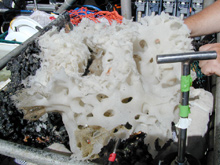
A large sponge in the basket of the submersible Alvin, collected during the Dive & Discover cruise. Photo by Jon Moore. Click image for larger view.
Besides several Alvin dives on the Dive & Discover cruise, other methods of viewing the seafloor were implemented, such as using a towed camera sled. The second camera tow got caught on the seafloor, and after dislodging and bringing it back to the surface, we discovered on top of the camera the largest number of intact D. cristagalli corals collected to date. The ten Alvin dives that actually occurred brought up numerous coral (gorgonian and antipatharian) and non-coral invertebrates. ABE (the Autonomous Benthic Explorer, a robot submarine), for the first time ever, was outfitted with a down-looking camera. These images from ABE, together with the Alvin and camera tow images comprised almost 48,000 digital photos. With the plethora of organisms and data collected, the scientists of the Dive & Discover cruise were able to leave the ship with the appropriate material to answer their individual questions.
Exactly what types of questions were the scientists aboard the Dive & Discover cruise looking to answer? They included growth, age structure, and dispersal of gorgonian corals (Lauren Mullineaux and Susan Mills), biodiversity and biogeography of faunal inhabitants (Jon Moore), molecular systematics and population connectivity of seamount faunal populations (Tim Shank and Kate Buckman), reproductive biology and ecology of scleractinian corals (Rhian Waller), and population genetic (and systematic) relationships of gorgonian and antipatharian corals (Scott France and Mercer Brugler). Other scientists were particularly interested in the rocks collected from the various seamounts, which were all coated in a thick manganese oxide layer. Even others were interested in putting together photo mosaics from the large number of images.
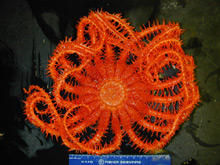
A large brisingid sea star collected from Manning Seamount. Photo by Jon Moore. Click image for larger view.
Ocean Explorer’s ‘Mountains in the Sea’ cruise continues the effort to characterize the New England seamounts. The current cruise looks to sample Manning, Kelvin, and Bear seamount, using information obtained from the NMFS, Deep East and Dive & Discover cruises (such as multibeam sonar data, and the various maps produced by ABE). Combining the previous cruises, only three out of 30 NE seamounts (Bear, Manning, and Gregg) have been sampled, along with another isolated seamount (Muir) that was also sampled.
Two seamounts will be resampled on this cruise, Bear and Manning. Because we now know that a large number of corals exist on the NE seamounts, we can attempt to accurately map the distribution of the octocorals and assess the overall diversity of organisms living on and among the coral communities. Other scientists are hoping to determine the reproductive state and potential larval strategies of seamount octocorals, and are also looking to investigate the colonization dynamics of dense coral aggregations using basaltic recruitment blocks. Another important question that will be addressed looks at the physical impact of bottom trawling on octocoral communities and seamount biodiversity, which is of utmost importance as the trawling industry is pushed to deeper waters (as the shallow water sources are becoming more and more depleted).
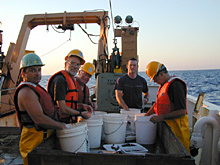
Sorting animals from the trawl catch at Bear Seamount in 2002. From left to right: Dr. Tracey Sutton, Dr. Jon Moore, Edward McChain, Chris Kenaly, Dr. Michael Vecchione. Photo by Ruth Gibbons. Click image for larger view.
After the current cruise, five northwestern Atlantic seamounts will have been partially explored. That is only 17 percent of New England seamount chain. Thus, it is imperative that the scientists of past NE seamount expeditions work with the scientists of future endeavors in order to pass along methods of collecting that both worked and failed, and to collaborate on what was found, and what still needs to be characterized. The New England seamounts are very diverse, and it is going to be very exciting to see the results of both this cruise and future cruises that explore this general area.
Getting there from here
July 15, 2003
Ivar Babb
Director
National Undersea Research Center (North Atlantic and Great Lakes)
Choosing where to dive with the Alvin submersible at first appears to be a daunting task. This challenge is magnified by the considerable investment that a single day at sea on the R/V Atlantis and DSV Alvin represents in terms of human, financial and career capital. However, unlike the mariners of old - who relied upon the stars, a sextant and a chronometer to locate themselves on the water, we are armed with a greater caliber of high-tech navigational tools that are used to locate a position 2,000 meters below the ocean’s surface. As is characteristic of most modern oceanographic studies, our search for the perfect dive spot is not solely limited to our use and understanding of technologies. It is guided by an understanding of the complex interaction of biological, chemical and physical properties and processes.
In the case of our exploration of the Mountains in the Sea, one of our primary targets is to study deep sea corals. Our work is guided by many talented biologists and ecologists who have contributed to the growing body of literature of what determines the distribution and abundance of the corals. Our first guidepost in locating the best dive spot is that we know that our target organisms generally occur at depths less than 2,500 meters. We also know that the deep sea corals rely completely on filtering the water column for their food, instead of gathering some of their energy from the sun like their shallow water counterparts.
With this knowledge, we turn to the physical oceanographers who have studied the predominant currents in the Atlantic - the northward flowing Gulf Stream current, the return flow from the Deep Western Boundary Undercurrent, the role of warm core rings and eddies, and the influence of the seamounts themselves on the flow of water. Our working hypothesis is that the series of seamounts we are exploring are impacted by the eastward flowing portion of the Deep Western Boundary Undercurrent, and that this impact should deliver the highest amount of suspended material, including food for the corals, to the western side of the seamounts. We also know from previous submersible work that local exposed topographic irregularities, such as ridges, tend to support higher densities of the deep sea coral suspension feeders.
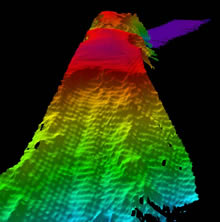
A bathymetry map of the Kelvin seamount showing the Western ridge where the scientists chose to dive in Alvin today. Image by N. Forfinski. Click image for larger view.
Armed with our biological and physical guideposts, we have been able to apply multibeam sonar mapping technology. This wonderful tool provides three-dimensional, geo-referenced maps of the seamounts that allow us to observe their precise depth and complex topography. Because the maps are geo-referenced, we are able to pick a dive spot that has a precise latitude and longitude associated with it. We then give this site information to the skilled crew of the R/V Atlantis and DSV Alvin submersible, and they are able to get us to our chosen spot. How they do that is another story.




















